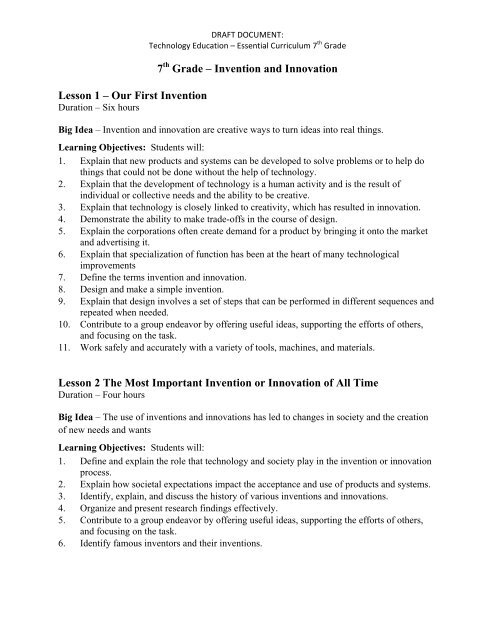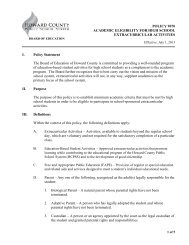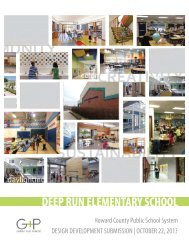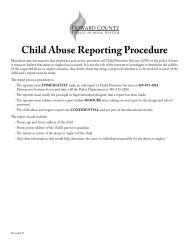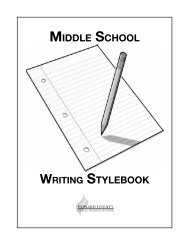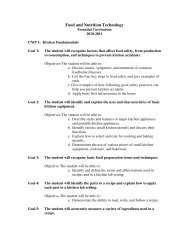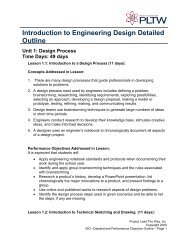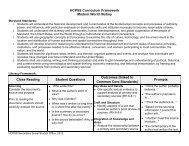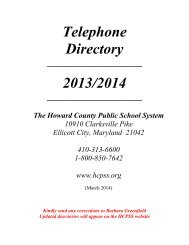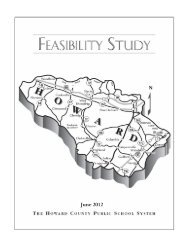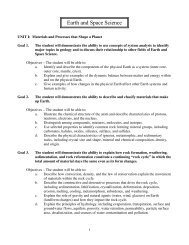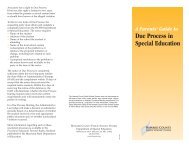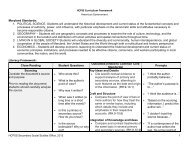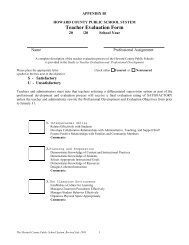7 Grade â Invention and Innovation Lesson 1 â Our First Invention ...
7 Grade â Invention and Innovation Lesson 1 â Our First Invention ...
7 Grade â Invention and Innovation Lesson 1 â Our First Invention ...
Create successful ePaper yourself
Turn your PDF publications into a flip-book with our unique Google optimized e-Paper software.
<strong>Lesson</strong> 1 – <strong>Our</strong> <strong>First</strong> <strong>Invention</strong>Duration – Six hoursDRAFT DOCUMENT:Technology Education – Essential Curriculum 7 th <strong>Grade</strong>7 th <strong>Grade</strong> – <strong>Invention</strong> <strong>and</strong> <strong>Innovation</strong>Big Idea – <strong>Invention</strong> <strong>and</strong> innovation are creative ways to turn ideas into real things.Learning Objectives: Students will:1. Explain that new products <strong>and</strong> systems can be developed to solve problems or to help dothings that could not be done without the help of technology.2. Explain that the development of technology is a human activity <strong>and</strong> is the result ofindividual or collective needs <strong>and</strong> the ability to be creative.3. Explain that technology is closely linked to creativity, which has resulted in innovation.4. Demonstrate the ability to make trade-offs in the course of design.5. Explain the corporations often create dem<strong>and</strong> for a product by bringing it onto the market<strong>and</strong> advertising it.6. Explain that specialization of function has been at the heart of many technologicalimprovements7. Define the terms invention <strong>and</strong> innovation.8. Design <strong>and</strong> make a simple invention.9. Explain that design involves a set of steps that can be performed in different sequences <strong>and</strong>repeated when needed.10. Contribute to a group endeavor by offering useful ideas, supporting the efforts of others,<strong>and</strong> focusing on the task.11. Work safely <strong>and</strong> accurately with a variety of tools, machines, <strong>and</strong> materials.<strong>Lesson</strong> 2 The Most Important <strong>Invention</strong> or <strong>Innovation</strong> of All TimeDuration – Four hoursBig Idea – The use of inventions <strong>and</strong> innovations has led to changes in society <strong>and</strong> the creationof new needs <strong>and</strong> wantsLearning Objectives: Students will:1. Define <strong>and</strong> explain the role that technology <strong>and</strong> society play in the invention or innovationprocess.2. Explain how societal expectations impact the acceptance <strong>and</strong> use of products <strong>and</strong> systems.3. Identify, explain, <strong>and</strong> discuss the history of various inventions <strong>and</strong> innovations.4. Organize <strong>and</strong> present research findings effectively.5. Contribute to a group endeavor by offering useful ideas, supporting the efforts of others,<strong>and</strong> focusing on the task.6. Identify famous inventors <strong>and</strong> their inventions.
DRAFT DOCUMENT:Technology Education – Essential Curriculum 7 th <strong>Grade</strong><strong>Lesson</strong> 3 The Engineering Design ProcessDuration – Three to Five hoursBig Idea – Technology involves many types of problems <strong>and</strong> different approaches to solve them,including troubleshooting, research <strong>and</strong> development, invention <strong>and</strong> innovation, <strong>and</strong>experimentation.Learning Objectives: Students will:1. Explain that design is a creative planning process that leads to useful products <strong>and</strong> systems.2. Explain why there is no perfect design.3. Explain that requirements for a design are made up of criteria <strong>and</strong> constraints.4. Explain that design involves a set of steps that can be performed in different sequences <strong>and</strong>repeated when needed.5. Explain that brainstorming is a group problem-solving design process in which each person in thegroup presents his or her ideas in an open forum.6. Explain that modeling, testing, evaluating, <strong>and</strong> modifying are used to transform ideas into practicalsolutions.7. Explain how marketing a product involves informing the public about it well as assisting in selling<strong>and</strong> distributing it.8. Explain how governmental regulations often influence the design <strong>and</strong> operation of transportationsystems.9. Apply the engineering design process to solve a problem.10. Identify <strong>and</strong> describe the major steps in the engineering design process.<strong>Lesson</strong> 4 Where Does the Trash Go?Duration – Four hoursBig Idea – Technology, by itself, is neither good nor bad, but decisions about the use of products<strong>and</strong> systems can result in desirable or undesirable consequences.Learning Objectives: Students will:1. Cite examples of the development <strong>and</strong> use of technology posing ethical problems.2. Explain that knowledge gained from other fields of study has a direct effect on thedevelopment of technological products <strong>and</strong> systems.3. Describe how economic, political, <strong>and</strong> cultural issues are influenced by the development<strong>and</strong> use of technology.4. Discuss the impacts of “waste materials” on the environment.5. Describe how various “waste materials” can be recycled, reused, or re-manufactured intonew products.6. Describe, analyze <strong>and</strong> evaluate the impacts that inventions <strong>and</strong> innovations have had on theenvironment.7. Use data collected to analyze <strong>and</strong> interpret trends in order to identify positive or negativeeffects of a technology.
DRAFT DOCUMENT:Technology Education – Essential Curriculum 7 th <strong>Grade</strong>8. Interpret <strong>and</strong> evaluate the accuracy of the information obtained <strong>and</strong> determine if it is useful.9. Contribute to a group endeavor by offering useful ideas, supporting the efforts of others,<strong>and</strong> focusing on the task.<strong>Lesson</strong> 5A Rube Goldberg ChallengeDuration –6 hoursBig Idea – <strong>Innovation</strong> is the process of modifying an existing product, process, or system orsystem to improve it. <strong>Invention</strong> is a process of turning ideas <strong>and</strong> imagination into new products,processes, or systems.Learning Objectives Students will learn to:1. Apply a design process to solve problems in <strong>and</strong> beyond the laboratory-classroom.2. Select criteria <strong>and</strong> constraints for the design.3. Make two-dimensional <strong>and</strong> three-dimensional representations of a design solution.4. Test <strong>and</strong> evaluate a design in relation to pre-established requirements, such as criteria <strong>and</strong>constraints, <strong>and</strong> refine as needed.5. Make a product or system <strong>and</strong> document the process.6. Safely use tools, products, <strong>and</strong> systems for specific tasks.7. Use computers <strong>and</strong> calculators in order to achieve a given purpose.8. Contribute to a group endeavor by offering useful ideas, supporting the efforts of others,<strong>and</strong> focusing on the task9. Work safely <strong>and</strong> accurately with a variety of tools, machines, <strong>and</strong> materials.<strong>Lesson</strong> 5B Stuck On a Desert Isl<strong>and</strong>Duration –6 hoursBig Idea – <strong>Innovation</strong> is the process of modifying an existing product, process, or system orsystem to improve it. <strong>Invention</strong> is a process of turning ideas <strong>and</strong> imagination into new products,processes, or systems.Learning Objectives Students will learn to:1. Explain that the development of technology is a human activity <strong>and</strong> is the result ofindividual or collective needs <strong>and</strong> the ability to be creative.2. Explain that technology is closely linked to creativity, which has resulted in innovation.3. Make a product or system <strong>and</strong> document the process.4. Select criteria <strong>and</strong> constraints for a design.5. Make two-dimensional <strong>and</strong> three-dimensional representations of a design solution.
DRAFT DOCUMENT:Technology Education – Essential Curriculum 7 th <strong>Grade</strong>6. Test <strong>and</strong> evaluate a design in relation to pre-established requirements, such as criteria <strong>and</strong>constraints, <strong>and</strong> refine as needed.7. Make a product or system <strong>and</strong> document the process.8. Safely use tools, products, <strong>and</strong> systems for specific tasks.9. Contribute to a group endeavor by offering useful ideas, supporting the efforts of others,<strong>and</strong> focusing on the task.<strong>Lesson</strong> 6 Computer Aided DesignDuration –4 hoursCourse Timeline<strong>Lesson</strong> Title Hours1 <strong>Our</strong> <strong>First</strong> <strong>Invention</strong> 62 The Most Important <strong>Invention</strong> or <strong>Innovation</strong> 4of All Time3 The Engineering Design Process 54 Where Does the Trash Go? 45A Rube Goldberg Challenge 65A Stuck On a Desert Isl<strong>and</strong> 66 Computer Aided Design 4Total hours 35


